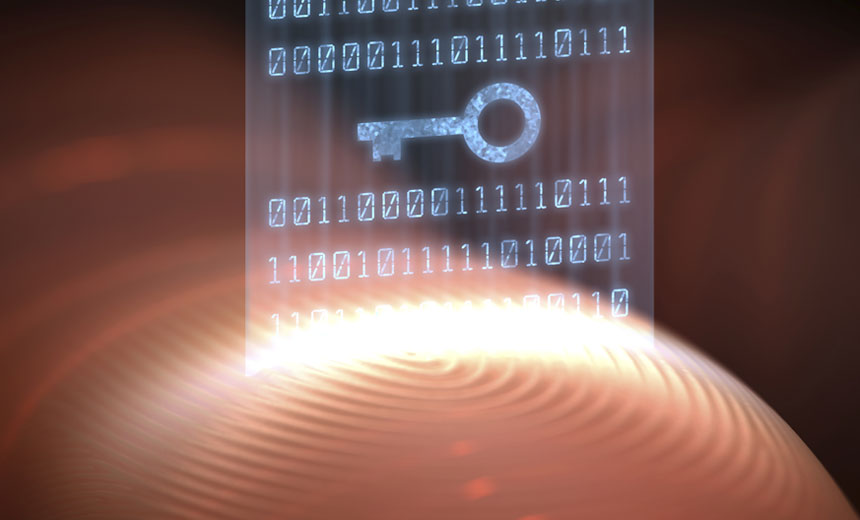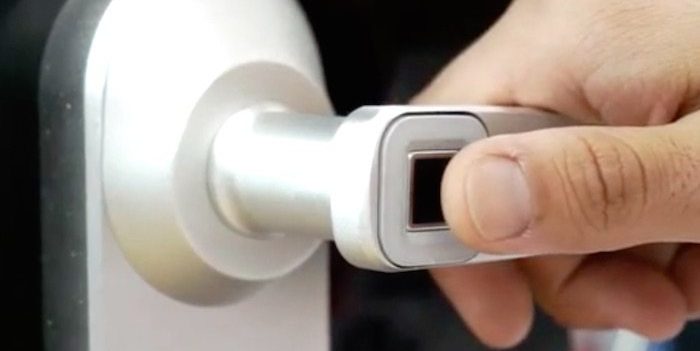
Biometric locks by definition, are locks that grant access based on a unique body trait of the person trying to open it. This can mean either your retina or your fingerprint. Here, we’ll be discussing primarily fingerprint locks, as retina scanners are not intended for personal use.
So, how do they work? Of course, they scan fingerprints. But the real question is how do they scan and then remember your fingerprint.
How Do Biometric Fingerprint Locks Work?
Here is where our own anatomy comes to the rescue. As you know, human fingerprints are unique for every individual. They are as personal and as special as our DNA. Based on this, biometric locks can recognize and separate different users.
The way fingerprint scanners scan is different, actually. There are the optical scanners, and they, in essence, take photos of your finger and then store the photo for matching. These types of scanners can be tricked by presenting a photo of the print. Another scanner, called a capacitor scanner, makes an electronic mold of your fingerprint. Of course, this scanner can be fooled by presenting the exact mold of the fingerprint.
The last type of scanner, Ultrasound, is the least likely to be fooled. This fingerprint reader uses high-frequency sound waves to penetrate the outer layer of the skin. They read the fingerprint on the inner, which eliminates the need for a clean surface and. These scanners are the hardest to trick, and they will not fall to any conventional tactics. this also makes them the most expensive, but also the most popular.
Locks with Multiple Factor Authentication
Multiple factor authentication or MFA is a method of gaining access by presenting several authenticating instances. This means that you have to present at least two types of authenticating code to unlock a lock. Usually, these instances are something a person knows, owns, or something they are. A Common method of multi-factor authentication would be knowing a password and swiping a key card.
When it comes to biometric locks and other biomertic devices, this is usually manifested as having a fingerprint (something you are) and a keypad for a code (something you know). When faced with these locks, you will not only have to introduce your finger print to the device, but you will have to input the code as well. Failing to produce either one of these authentications will result in the lock not yielding entry.
Two factor authentication should be utilized when you want to obtain high levels of security.
Fingerprint Lock Pros and Cons
 These locks are generally considered the most secure option of all common security door locks. They simply require an authorized user access based on a bodily trait. There is no key that you have to worry about losing and it can’t be picked.
These locks are generally considered the most secure option of all common security door locks. They simply require an authorized user access based on a bodily trait. There is no key that you have to worry about losing and it can’t be picked.
As with anything, there are some cons to biometric fingerprint locks. One of the main disadvantages of these locks has been stated above, and is dependent on the type of fingerprint scanner used. Its important to ensure you know what technology is installed in your device before you consider purchasing one.
There is one flaw that effects all biometric locks, they have to use electricity to keep running. Usually, residential locks use batteries, and batteries run out. If that happens, you might just be locked out of your house, with no way of getting in. This is primarily why these locks typically come with an override key.
Biometric vs Mechanical Locks
In the case of mechanical locks its impossible for it to loose power, as they require no power to operate.
However, the cons of mechanical locks are many. First off, these locks can be easily picked, or you can have your key stolen. In the case of a fingerprint scanner, you cannot forget your fingerprint (obviously), and it cannot be stolen. Even if your finger has been cut off most bio locks won’t recognize it because there is no pulse and no body heat.
Fingerprint vs Other High Security Locks
Fingerprint scanners are also ahead when compared with other biometric locking devices. When it comes to voice recognition locks, fingerprint locks are much more reliable . If your voice is coarse even a little bit (like if you have a cold), the lock won’t recognize it and you will be denied entry. Retina scanners are better than fingerprint locks, but they are not up for commercial use, due to their incredibly high cost.
Practical Uses of Finger Print Locks
 Overall, commercially, fingerprint locks are very reliable and good. They can be used by residents or commercially for offices and warehouses. In fact, wherever there is a need to protect property or valuable information, you may find it that a fingerprint lock is very well suited for the job. Common uses are on home safes, hand gun safes, padlocks, computers, and both interior and exterior doors. There are even fingerprint scanners built into time and attendance clocks for employers to prevent employee time fraud and unauthorized entry.
Overall, commercially, fingerprint locks are very reliable and good. They can be used by residents or commercially for offices and warehouses. In fact, wherever there is a need to protect property or valuable information, you may find it that a fingerprint lock is very well suited for the job. Common uses are on home safes, hand gun safes, padlocks, computers, and both interior and exterior doors. There are even fingerprint scanners built into time and attendance clocks for employers to prevent employee time fraud and unauthorized entry.
For practical purposes fingerprint locks are quite good. They are very convenient and fairly cheap. They, of course, cost more than mechanical locks, but they are also infinitely more secure. For these high security locks, you get what you pay for.
Like we said above, a key can be stolen and then used by an intruder to gain access to your possessions or your family. When it comes to fingerprint locks, the intruder is faced with a much harder task of getting in.
Of course, these locks aren’t foolproof. They can be faulty by themselves, and they may not recognize your own fingerprint, which leads to much frustration. If you were to cut your finger and if the cut were to leave a scar, you may not be able to use the scanner, as the lock will now treat it like a new fingerprint.
Before Buying a Biometric Lock…
Lastly, let’s talk about some of the things you need to look for when buying a biometric lock.
The first thing you need to look out for is the False Rejection Rate. This rate determines how often will the lock reject an already memorized fingerprint. If the lock has a very high FRR, you will certainly want to avoid it.
The next thing you will want to look into is the material used to make the lock. Locks that are made of brass or steel are much sturdier than aluminum ones. Aluminum ones can be easily be bent or broken and a thief armed with crowbar might just be able to pull it out completely. Your device is also only as secure as the door you install it on. If you are putting it on a hollow wood door, there is nothing preventing an intruder from kicking through the door.
Also, it is a good thing to invest into a deadbolt. While mortises are just as effective, the feeling of a solid steel bar being rammed into the door frame will make you feel quite a bit safer. While there aren’t as many options for bio locks with deadbolts, there are some that are built particularly well.
Lastly, it is not a bad idea to invest in a lock with an alternative opening system. Be it a key or a keypad, this will prove invaluable to you in case the fingerprint recognition system fails. In addition you can utilize two factor authentication if your need calls for the most secure option.
Biometric Locks – Conclusion
Well, now you know all there is to know about biometric locks. So, why not go down to your local hardware store, or go online and get yourself one? If you don’t know which one to choose, we also have an article containing 5 excellent fingerprint door locks for you to choose from. Here are some biometric locks on Amazon…
 Biometric Lock Reviews Find the best finger print scanner online
Biometric Lock Reviews Find the best finger print scanner online 